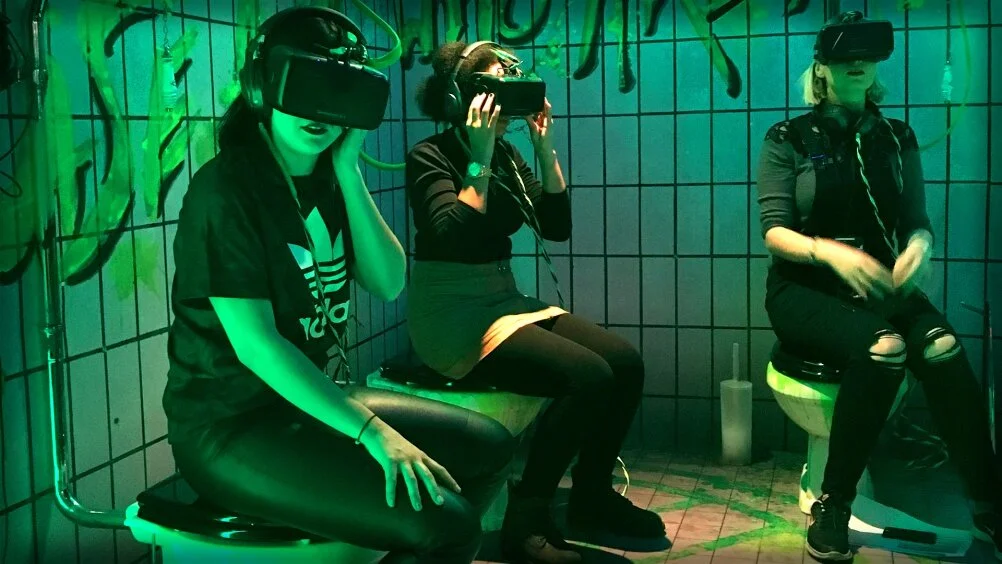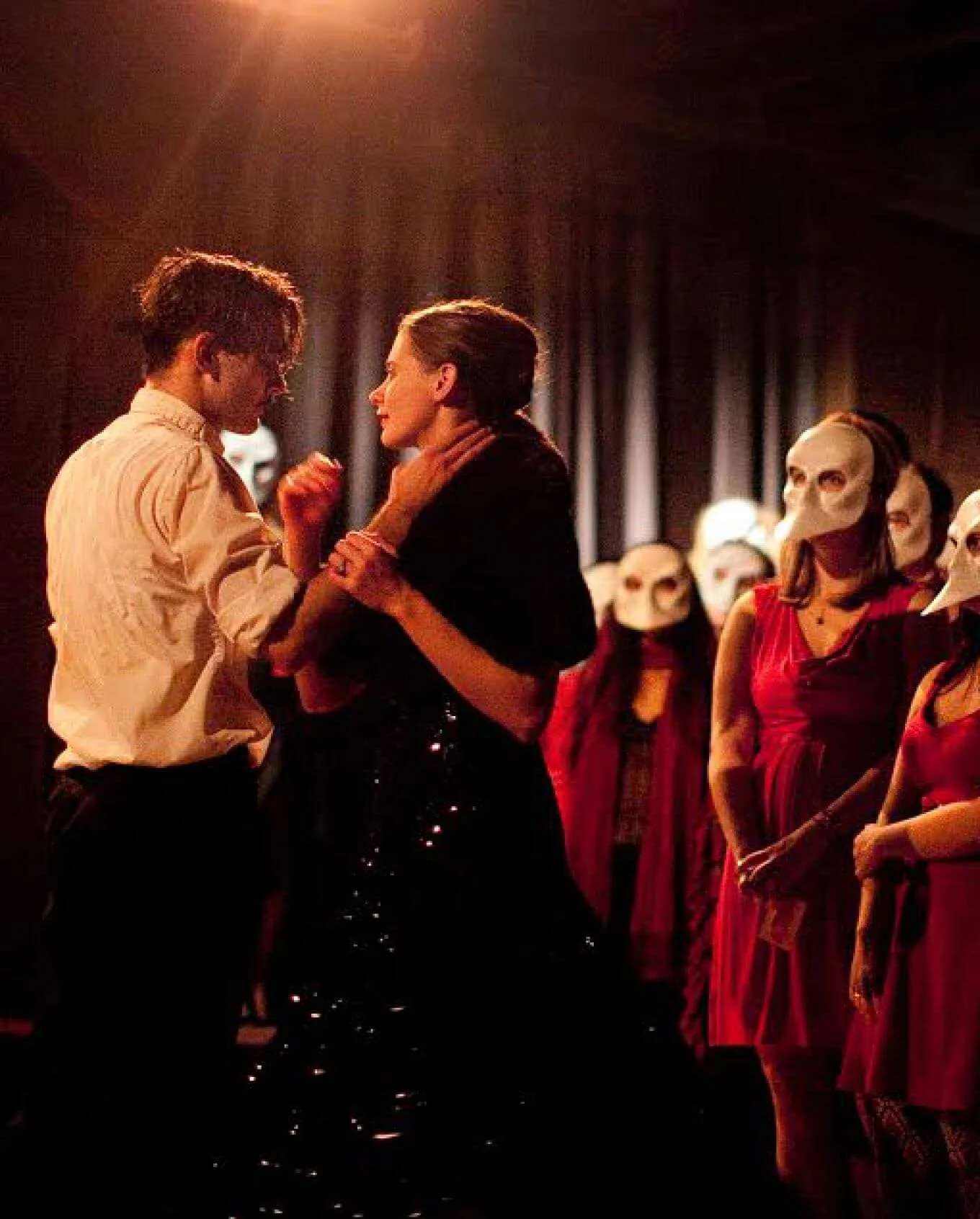Written by Amelia Stevens
In the ever-changing and technologically advanced age that we are currently in, there are integrations of new technologies into our lives almost everyday, and the arts are no exception. The world of theater, especially that of immersive theater, has been experiencing a technological revolution of its own thanks to advancements in and the adoption of virtual reality (VR) and augmented reality (AR). What makes immersive theater so pliable to the addition of the elements of both VR and AR, as well as the impact they are having on industry standards for creators and performers, will be explained and explored below in order to gain an understanding of what the future of immersive theater experiences might look like.
What is Immersive Theater?
Figure 1: Image from “Sleep No More.” Source: FoST.
What defines immersive theater as a style of theater performance is the way in which the storytelling elements of it are centered around the ability of create intimacy. Although the emotional vulnerability of actors performing on stage in a typical theater setting is enough to elicit emotional connections and create meaningful experiences for audience members, immersive theatre takes it one step further. By eliminating the distance between audience members and actors, and placing them in the same physical space together, the existence of the fourth wall is effectively broken down, creating a unique vulnerability and opportunity for connection. Immersive theater creates such strong ties between audiences and actors through engaging all the senses of the audience member and utilizing unique structure. This allows for storytelling to be developed in a manner that is interactive and deeply personal, making audience members part of the story rather than observers of the story. This does vary to different degrees depending on how interactive a piece may or may not be, but the other hallmarks of this style still stand. Since audience members are already willing to move away from the more traditional elements of theater through immersive theater, adding in elements of VR and AR is not a hard sell, which is exactly why it is a rising trend.
Virtual Reality and Augmented Reality
Today, VR is defined as “a computer-generated environment with scenes and objects that appear to be real, making the user feel they are immersed in their surroundings,” while AR is defined as when “our own world becomes the framework within which objects, images, or similar technologies are placed.”
Figure 2: A video on how virtual reality tricks your brain. Source: Vox on YouTube.
As discussed in the Vox video above, virtual reality utilizes differently angled lenses inside VR headsets to simulate human stereoscopic vision, or depth perception, in order to create spaces that our brains perceive as realistic. Three hundred sixty-degree visuals and audio are also created and employed in VR headsets so that a user feels immersed in the world as it mimics how vision and hearing function in reality via head tracking. Head tracking places the user in the first-person perspective in the digital world and then follows their movements in a realistic way, which allows for almost complete immersion as the image frame rates are quick enough to convince our brains that what we are seeing is real. AR works in a very different way. It is more interactive and less immersive. AR utilizes the 3D imaging processors of the navigation systems that are already embedded in smartphones, in combination with object recognition software, to overlay digital images onto the space around us. Like VR, it operates at high framing rates to allow us to perceive it as realistically as possible. This is all possible thanks to the smartphone processors that allow for both VR and AR to be accessed in just a few short clicks.
The Integration of VR and AR into Immersive Theater
The implementation of VR and AR into immersive theater is happening globally, and in many ways. The immersive entertainment industry as a whole was reported as being valued at more than $60 billion dollars in 2019, with immersive theater contributing just over $28 million dollars to the total. One of the leaders of VR integration with immersive theater is the National Theatre in London. The National Theatre is known for its cutting edge and boundary pushing productions, such as its performances of the VR musical adaptation of Lewis Carroll’s “Alice in Wonderland” titled “Wonder.land” by Damon Albarn in 2016. The National Theatre is not only producing fully fledged productions in this vein. It also launched an artist support project entitled “alt.barbican,” which encouraged theater makers who had creative ideas that blended VR and AR with immersive theater performance in 2017. More recently, however, in 2019, the National Theatre received a Sundance nomination for its VR production of “All Kinds of Limbo” by Raffy Bushman and Nubiya Brandon.
Though the National Theatre has made notable strides in this realm, it is not the only theater to see success. In a collaboration between Piehole, a theater company in Los Angeles, and Tender Claws, an L.A. game development company, “The Under Presents” was born. This immersive theater experience utilizes the VR technology of Oculus Quest, powered by Facebook, to create a video game meets live cabaret adventure experience. Though this is a largely individual, game driven experience, there are actors, live interactions, and even elements of advanced puppetry that make this an extremely unique immersive theater experience. Although this project was originally developed in 2016, the unusual circumstances that surrounded life in 2020 lead to its revitalization and widespread success, obtaining a nomination and win for “VR Experience of the Year” in 2020 by The Virtual Reality Awards. This success is a strong example of how immersive theater has been influenced by the addition of VR and AR into performance in just the last year, and represents the indicators of change in the field.
How Have VR and AR changed Immersive Theater?
Though the VR and AR technologies that exist in our current age have been employed in many different avenues—including healthcare education, law enforcement training, and the entertainment industry—immersive theater experienced a dramatic increase in engagement in the wake of the Covid-19 pandemic. As life around the globe was altered, the addition of virtual and augmented reality to immersive theater provided an avenue for consumers to enjoy these experiences from the comfort of their own homes. The success of “The Under Presents” illustrates how audiences are increasingly interested in having these kinds of experiences as long as the opportunity is at hand.
The ability to reach new audiences and provide access to productions to larger populations is a large benefit to VR and immersive theater, but the largest effect that this integration has had on immersive theater is in the reshaping of creative storytelling. Immersive theater, as previously discussed, had typically been defined as a performance piece that was inherently tied to the physical space in which it takes place, infusing and using said space to help tell the story. VR experiences, however, take away the physical space and create a digital one. This presents an exciting, new challenge for creators who, as long as they themselves understand the use of the technology or can partner with a fellow creator who does, can find completely new avenues for immersive storytelling with elements that were never considered possible back at the dawning of immersive theater in 1971.
However, this does change industry standards for creators, as the expectation to produce cutting edge work in this realm is now tied to the inclusion of VR and AR elements. This is challenging for theaters and creatives who may not have the skills or monetary means necessary to produce this kind of work, which is precisely why the “alt.barbican” project and others like it are so relevant and important. For performers, this requires not only flexibility and adaptability to working within the confines of the technology but requires expert improvisation skills since actors are expected to think on their feet with each new audience member that they encounter. This does mean, however, that audiences are having a personalized, one-of-a-kind experience, which is exactly what immersive theater is and was always meant to be. So, how do these shifting standards impact the world of theater as a whole?
Figure 3: “Wonder.land” virtual reality experience. Source: Design Week, © Play Nicely 2015.
The Future of Theater
The integration of VR and AR have allowed for the increased success of immersive theater experiences over the past few years due to the ability of these performances to remain unique and emotional while growing the style and challenging creators and performers in engaging ways. Virtual reality can also be taken in a different direction and, rather than being incorporated into the development of a performance, can be the canvas on which a show takes place. “Hamlet 360: Thy Father’s Spirit,” created, developed, and presented by Commonwealth Shakespeare Company in 2019, is a VR adaptation of “Hamlet” by William Shakespeare. This production offered audiences the opportunity to view the performance of “Hamlet” in a VR space, though the production was not reliant on the integration of the technology.
This utilization of VR and AR also extends to the world of all live performance. Musical artists have been applying this format to concert performances at increasing rates as well. It is likely that as long as audience interest in this technology continues to grow, the future of theater will only become more and more intertwined with it. Virtual and augmented reality, though they pose technological challenges, also provide the opportunity for the future of theater to become increasingly accessible. Despite the difficulties of 2020 and the sentiments that traditional performances are old hat, the world of theater has proven that it is ever-evolving with technology and with the times, showing that it is here to stay and may just be viewable in your own living room.
+ Resources
Aaron Halls Special to The Post and Courier. “A Brief History of Immersive Theater.” Post and Courier. The Post and Courier, September 14, 2020. https://www.postandcourier.com/spoleto/a-brief-history-of-immersive-theater/article_baf19760-637c-11e8-b8ad-3b7339b572ac.html.
Anurag. “How VR Works? Know The Technology Behind Virtual Reality.” NewGenApps, August 25, 2020. https://www.newgenapps.com/blog/how-vr-works-technology-behind-virtual-reality/.
Blippar. “What Is Augmented Reality (AR) and How Does It Work? - Blog.” Blippar. Accessed April 9, 2021. https://www.blippar.com/blog/2018/08/21/what-is-augmented-reality-and-how-does-augmented-reality-work.
Brigante, Ricky, and Sarah A.S. Elger. “New Adventures: The Strength of Immersive Entertainment.” 2020 Immersive Entertainment Industry Annual Report. HERE Institute, May 20, 2020. https://everythingimmersive.com/storage/website-files/documents/2020%20Immersive%20Entertainment%20Industry%20Annual%20Report.pdf.
Corporativa, Iberdrola. “Virtual Reality: Another World within Sight.” Iberdrola. Accessed April 9, 2021. https://www.iberdrola.com/innovation/virtual-reality.
Eckert, Stephen. “What Is Immersive Theater?” Contemporary Performance, January 18, 2021. https://contemporaryperformance.com/2017/12/09/immersive-theater/.
Esteves, Augusto. “Is VR the Future of Live Performance?” The Theater Times, October 31, 2017. https://thetheatretimes.com/vr-future-live-performance/.
“Hamlet 360: Thy Father's Spirit.” Commonwealth Shakespeare Company. Accessed April 9, 2021. https://commshakes.org/production/hamlet-360-thy-fathers-spirit/.
Hernandez, (SES) Philip. “The Future of Immersive Entertainment in a Post-Pandemic World.” Seasonal Entertainment Source, May 2, 2020. https://seasonalentertainmentsource.com/immersive-entertainment-after-covid-19/.
“History Of Virtual Reality.” Virtual Reality Society, January 2, 2020. https://www.vrs.org.uk/virtual-reality/history.html.
“Immersive Storytelling Studio: Altbarbican.” National Theatre, March 10, 2020. https://www.nationaltheatre.org.uk/immersive/projects/alt-barbican.
Marsh, Katie. “The National Theater's Immersive VR Experience ALL KINDS OF LIMBO Has Been Selected for Sundance Film Festival 2020.” Press Release. National Theater, December 19, 2019. https://www.nationaltheatre.org.uk/sites/default/files/national_theatres_all_kinds_of_limbo_selected_for_sundance_2020.pdf.
Medium. Accessed April 9, 2021. https://noproscenium.com/how-immersive-virtual-reality-theatre-pushes-the-limits-of-storytelling-8265b198bfc7.
“Panorama.” Encyclopædia Britannica. Encyclopædia Britannica, inc. Accessed April 9, 2021. https://www.britannica.com/art/panorama-visual-arts.
“Sleep No More: from Avant Garde Theatre to Commercial Blockbuster.” The Guardian. Guardian News and Media, March 31, 2015. https://www.theguardian.com/stage/2015/mar/31/sleep-no-more-avant-garde-theatre-new-york.
Stein, Scott. “You Won't Know Who's Real inside This Immersive Theater VR Experience.” CNET. CNET, November 23, 2019. https://www.cnet.com/news/you-wont-know-who-is-real-inside-this-immersive-theater-vr-experience/.
Theater, Author: New York. “What Is Immersive Theater? The Six Elements That Define It at Its Best.” New York Theater, September 29, 2020. https://newyorktheater.me/2019/10/04/what-is-immersive-theater-the-six-elements-that-define-it-at-its-best/.
“The Under Presents.” Aims Zhang. Accessed April 9, 2021. https://www.aimeezh.com/tup.



